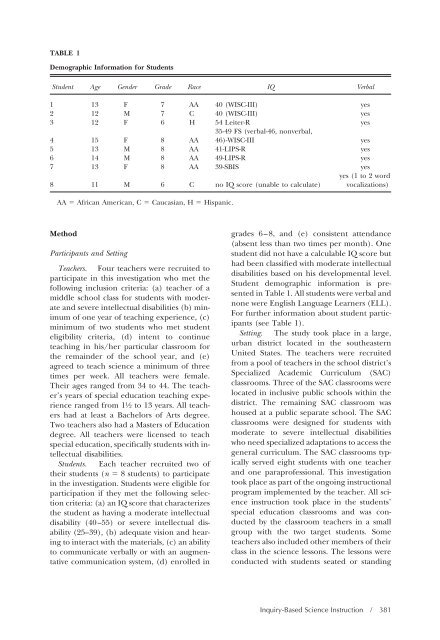Education and Training in Autism and Developmental Disabilities
Education and Training in Autism and Developmental Disabilities
Education and Training in Autism and Developmental Disabilities
Create successful ePaper yourself
Turn your PDF publications into a flip-book with our unique Google optimized e-Paper software.
TABLE 1<br />
Demographic Information for Students<br />
Student Age Gender Grade Race IQ Verbal<br />
1 13 F 7 AA 40 (WISC-III) yes<br />
2 12 M 7 C 40 (WISC-III) yes<br />
3 12 F 6 H 54 Leiter-R<br />
35-49 FS (verbal-46, nonverbal,<br />
yes<br />
4 15 F 8 AA 46)-WISC-III yes<br />
5 13 M 8 AA 41-LIPS-R yes<br />
6 14 M 8 AA 49-LIPS-R yes<br />
7 13 F 8 AA 39-SBIS yes<br />
yes (1 to 2 word<br />
8 11 M 6 C no IQ score (unable to calculate) vocalizations)<br />
AA African American, C Caucasian, H Hispanic.<br />
Method<br />
Participants <strong>and</strong> Sett<strong>in</strong>g<br />
Teachers. Four teachers were recruited to<br />
participate <strong>in</strong> this <strong>in</strong>vestigation who met the<br />
follow<strong>in</strong>g <strong>in</strong>clusion criteria: (a) teacher of a<br />
middle school class for students with moderate<br />
<strong>and</strong> severe <strong>in</strong>tellectual disabilities (b) m<strong>in</strong>imum<br />
of one year of teach<strong>in</strong>g experience, (c)<br />
m<strong>in</strong>imum of two students who met student<br />
eligibility criteria, (d) <strong>in</strong>tent to cont<strong>in</strong>ue<br />
teach<strong>in</strong>g <strong>in</strong> his/her particular classroom for<br />
the rema<strong>in</strong>der of the school year, <strong>and</strong> (e)<br />
agreed to teach science a m<strong>in</strong>imum of three<br />
times per week. All teachers were female.<br />
Their ages ranged from 34 to 44. The teacher’s<br />
years of special education teach<strong>in</strong>g experience<br />
ranged from 1½ to 13 years. All teachers<br />
had at least a Bachelors of Arts degree.<br />
Two teachers also had a Masters of <strong>Education</strong><br />
degree. All teachers were licensed to teach<br />
special education, specifically students with <strong>in</strong>tellectual<br />
disabilities.<br />
Students. Each teacher recruited two of<br />
their students (n 8 students) to participate<br />
<strong>in</strong> the <strong>in</strong>vestigation. Students were eligible for<br />
participation if they met the follow<strong>in</strong>g selection<br />
criteria: (a) an IQ score that characterizes<br />
the student as hav<strong>in</strong>g a moderate <strong>in</strong>tellectual<br />
disability (40–55) or severe <strong>in</strong>tellectual disability<br />
(25–39), (b) adequate vision <strong>and</strong> hear<strong>in</strong>g<br />
to <strong>in</strong>teract with the materials, (c) an ability<br />
to communicate verbally or with an augmentative<br />
communication system, (d) enrolled <strong>in</strong><br />
grades 6–8, <strong>and</strong> (e) consistent attendance<br />
(absent less than two times per month). One<br />
student did not have a calculable IQ score but<br />
had been classified with moderate <strong>in</strong>tellectual<br />
disabilities based on his developmental level.<br />
Student demographic <strong>in</strong>formation is presented<br />
<strong>in</strong> Table 1. All students were verbal <strong>and</strong><br />
none were English Language Learners (ELL).<br />
For further <strong>in</strong>formation about student participants<br />
(see Table 1).<br />
Sett<strong>in</strong>g. The study took place <strong>in</strong> a large,<br />
urban district located <strong>in</strong> the southeastern<br />
United States. The teachers were recruited<br />
from a pool of teachers <strong>in</strong> the school district’s<br />
Specialized Academic Curriculum (SAC)<br />
classrooms. Three of the SAC classrooms were<br />
located <strong>in</strong> <strong>in</strong>clusive public schools with<strong>in</strong> the<br />
district. The rema<strong>in</strong><strong>in</strong>g SAC classroom was<br />
housed at a public separate school. The SAC<br />
classrooms were designed for students with<br />
moderate to severe <strong>in</strong>tellectual disabilities<br />
who need specialized adaptations to access the<br />
general curriculum. The SAC classrooms typically<br />
served eight students with one teacher<br />
<strong>and</strong> one paraprofessional. This <strong>in</strong>vestigation<br />
took place as part of the ongo<strong>in</strong>g <strong>in</strong>structional<br />
program implemented by the teacher. All science<br />
<strong>in</strong>struction took place <strong>in</strong> the students’<br />
special education classrooms <strong>and</strong> was conducted<br />
by the classroom teachers <strong>in</strong> a small<br />
group with the two target students. Some<br />
teachers also <strong>in</strong>cluded other members of their<br />
class <strong>in</strong> the science lessons. The lessons were<br />
conducted with students seated or st<strong>and</strong><strong>in</strong>g<br />
Inquiry-Based Science Instruction / 381

















